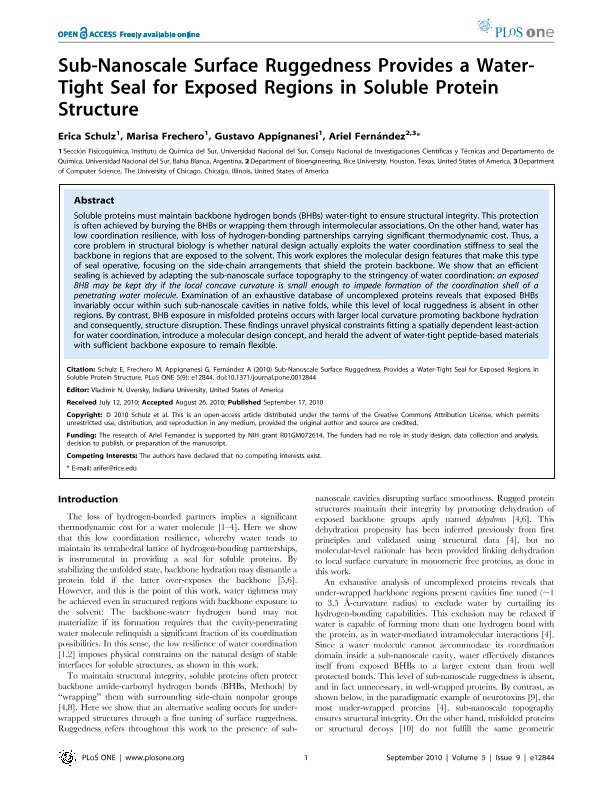Mostrar el registro sencillo del ítem
dc.contributor.author
Schulz, Erica Patricia

dc.contributor.author
Frechero, Marisa Alejandra

dc.contributor.author
Appignanesi, Gustavo Adrian

dc.contributor.author
Fernández, Ariel
dc.date.available
2018-11-09T14:11:41Z
dc.date.issued
2010-09
dc.identifier.citation
Schulz, Erica Patricia; Frechero, Marisa Alejandra; Appignanesi, Gustavo Adrian; Fernández, Ariel; Sub-nanoscale surface ruggedness provides a water-tight seal for exposed regions in soluble protein structure; Public Library of Science; Plos One; 5; 9; 9-2010; 1-5
dc.identifier.issn
1932-6203
dc.identifier.uri
http://hdl.handle.net/11336/64062
dc.description.abstract
Soluble proteins must maintain backbone hydrogen bonds (BHBs) water-tight to ensure structural integrity. This protection is often achieved by burying the BHBs or wrapping them through intermolecular associations. On the other hand, water has low coordination resilience, with loss of hydrogen-bonding partnerships carrying significant thermodynamic cost. Thus, a core problem in structural biology is whether natural design actually exploits the water coordination stiffness to seal the backbone in regions that are exposed to the solvent. This work explores the molecular design features that make this type of seal operative, focusing on the side-chain arrangements that shield the protein backbone. We show that an efficient sealing is achieved by adapting the sub-nanoscale surface topography to the stringency of water coordination: an exposed BHB may be kept dry if the local concave curvature is small enough to impede formation of the coordination shell of a penetrating water molecule. Examination of an exhaustive database of uncomplexed proteins reveals that exposed BHBs invariably occur within such sub-nanoscale cavities in native folds, while this level of local ruggedness is absent in other regions. By contrast, BHB exposure in misfolded proteins occurs with larger local curvature promoting backbone hydration and consequently, structure disruption. These findings unravel physical constraints fitting a spatially dependent least-action for water coordination, introduce a molecular design concept, and herald the advent of water-tight peptide based materials with sufficient backbone exposure to remain flexible. © 2010 Schulz et al.
dc.format
application/pdf
dc.language.iso
eng
dc.publisher
Public Library of Science

dc.rights
info:eu-repo/semantics/openAccess
dc.rights.uri
https://creativecommons.org/licenses/by-nc-sa/2.5/ar/
dc.subject
Proteins
dc.subject
Biological Water
dc.subject
Water Structure
dc.subject.classification
Otras Ciencias Biológicas

dc.subject.classification
Ciencias Biológicas

dc.subject.classification
CIENCIAS NATURALES Y EXACTAS

dc.title
Sub-nanoscale surface ruggedness provides a water-tight seal for exposed regions in soluble protein structure
dc.type
info:eu-repo/semantics/article
dc.type
info:ar-repo/semantics/artículo
dc.type
info:eu-repo/semantics/publishedVersion
dc.date.updated
2018-11-05T19:14:29Z
dc.journal.volume
5
dc.journal.number
9
dc.journal.pagination
1-5
dc.journal.pais
Estados Unidos

dc.journal.ciudad
San Francisco
dc.description.fil
Fil: Schulz, Erica Patricia. Consejo Nacional de Investigaciones Científicas y Técnicas. Centro Científico Tecnológico Conicet - Bahía Blanca. Instituto de Química del Sur. Universidad Nacional del Sur. Departamento de Química. Instituto de Química del Sur; Argentina
dc.description.fil
Fil: Frechero, Marisa Alejandra. Consejo Nacional de Investigaciones Científicas y Técnicas. Centro Científico Tecnológico Conicet - Bahía Blanca. Instituto de Química del Sur. Universidad Nacional del Sur. Departamento de Química. Instituto de Química del Sur; Argentina
dc.description.fil
Fil: Appignanesi, Gustavo Adrian. Consejo Nacional de Investigaciones Científicas y Técnicas. Centro Científico Tecnológico Conicet - Bahía Blanca. Instituto de Química del Sur. Universidad Nacional del Sur. Departamento de Química. Instituto de Química del Sur; Argentina
dc.description.fil
Fil: Fernández, Ariel. Rice University; Estados Unidos
dc.journal.title
Plos One

dc.relation.alternativeid
info:eu-repo/semantics/altIdentifier/doi/https://dx.doi.org/10.1371/journal.pone.0012844
dc.relation.alternativeid
info:eu-repo/semantics/altIdentifier/url/https://journals.plos.org/plosone/article?id=10.1371/journal.pone.0012844
Archivos asociados
